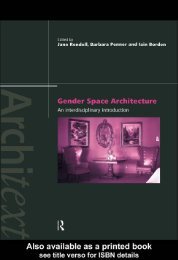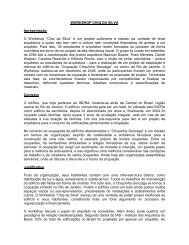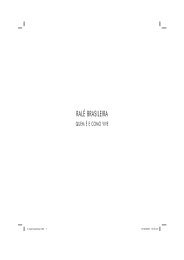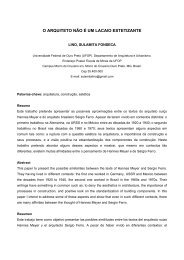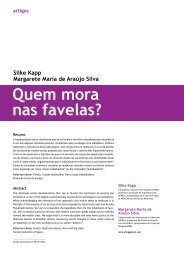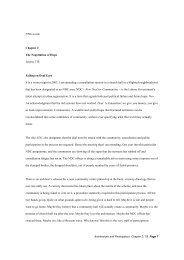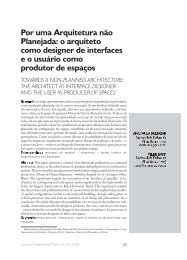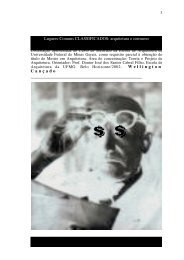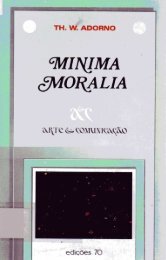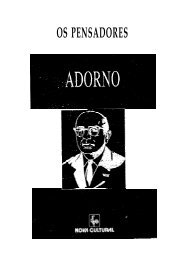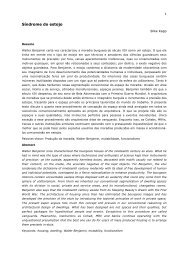Architecture and Modernity : A Critique
Architecture and Modernity : A Critique
Architecture and Modernity : A Critique
You also want an ePaper? Increase the reach of your titles
YUMPU automatically turns print PDFs into web optimized ePapers that Google loves.
186<br />
if it is rightly applied—”right” not in political but in disciplinary, artistic-autonomous<br />
terms—vouches for its critical character, even apart from the personal intention of<br />
the artist. Works of art yield a kind of knowledge of reality. This knowledge is critical<br />
because the mimetical moment is capable of highlighting aspects of reality that were<br />
not perceivable before. Through mimesis, art establishes a critical relation with social<br />
reality.<br />
Because art in Adorno’s view plays the role of an oppositional activity, Michael<br />
Cahn calls his concept of mimesis “subversive”: “According to Adorno, art must<br />
differ from the social in order to remain art. At the same time, however, it must be<br />
similar to its opposite in order to be possible as critique, since only the mutual<br />
involvement of critique <strong>and</strong> its object avoids the Hegelian double-bind in which two<br />
conflicting statements oppose each other unresolvably.” 74 In order to carry out a genuine<br />
critique, it is necessary for works of art to identify to a certain extent with what<br />
they are in revolt against. This notion can be seen, for instance, in a passage in which<br />
Adorno states that works of art are in a certain sense allied to the death principle. Because<br />
they remove that which they objectify from the immediacy of life, they submit<br />
by way of mimesis to reification, which, as a social realization of instrumental<br />
thought, nevertheless constitutes their own death principle. It is precisely here that<br />
Adorno sees the precondition for genuine critique: “Without the admixture of poison,<br />
virtually the negation of life, the opposition of art to civilizatory repression would<br />
amount to nothing more than impotent comfort.” 75 In order not to fall back into useless<br />
consolation, in order to serve as genuine critique, art is obliged to enter into a relation<br />
of similarity with reality, against which it levels its criticism. Art must become<br />
“Mimesis an ihr Widerspiel” (mimesis of its opposite): “Art was compelled to this by<br />
its social reality. Whereas art opposes society, it is nevertheless unable to take up a<br />
position beyond it; it achieves opposition only through identification with that against<br />
which it remonstrates.” 76<br />
This is also why Adorno states that works of art can exercise a critique of the<br />
dominant thought only inasmuch as they at least in part have made this dominant<br />
thought their own: “The opposition of artworks to domination is mimesis of domination.<br />
They must assimilate themselves to the comportment of domination in order<br />
to produce something qualitatively distinct from the world of domination.” 77 Cahn<br />
compares the strategy that Adorno describes with the medical principle of inoculation:<br />
in order to give the patient immunity to a certain sickness, he is infected with it,<br />
but in a controlled manner. In the same way art should be “infected” with the reification<br />
that it in fact opposes. The control organ that according to Adorno is employed<br />
in art (to round out Cahn’s metaphor) is reason: art is not simply mimesis; through<br />
reason it becomes a controlled form of mimesis. It is precisely this interplay between<br />
mimesis <strong>and</strong> reason that puts art in a position where it is able to exercise criticism.<br />
The mimetic impulse, according to Adorno, has to do with a gesture of negation:<br />
the work of art does not produce a positive image of reality or a positive image<br />
of what a utopian, ideal reality might be. On the contrary, the image it produces is a<br />
187



